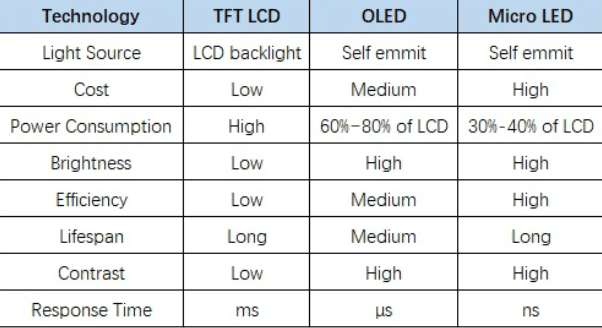LED – Light Emitting Display is just a light-emitting diode
VFD – Vacuum Fluorescent Display, with a fixed display image
LCD – Liquid Crystal Display, which is a typical LCD screen, most mobile phone screens are
OLED – Organic Light Emitting Display, also known as Organic Light Emitting Display, does not require backlighting and uses a very thin organic material coating and glass substrate. When current passes through, these organic materials will emit light. OLED display screen is lighter and thinner than LCD
IPS (In Plane Switching) hard screen technology is currently the most advanced LCD panel technology in the world.
In terms of resolution: LED has the lowest resolution, followed by VFD, OLED has the highest resolution, and LCD has the highest resolution. The resolution here refers to the spacing between the display units on their patterns, regardless of the size of the display units themselves.
In terms of contrast: OLED has the highest contrast, followed by VFD, slightly worse LED (not necessarily), and worst LCD (not necessarily)

In terms of brightness: OLED is the highest, LED may also be the highest, followed by VFD, and LCD may be the worst (not necessarily)
In terms of chromaticity: OLED is the best, followed by LED, LCD is slightly worse (not necessarily), and VFD is the worst
In terms of response speed: OLED and VFD are better, while LED and LCD are slightly worse.
VFD has the characteristics of filament and grid, as well as the presence of these components. These are visible. At least I can see it.
VFD has few colors and fixed color areas. There are many other colors, but basically they are displayed in different regions, but different things have different area sizes, and sometimes they cannot be directly distinguished by the naked eye.
At present, the commonly used OLEDs do not seem to be able to achieve full color, at least on ordinary civilian products, although technically possible.
OLED (Organic Light Emitting Diode) is fundamentally different from the traditional LCD display method mentioned earlier. It does not require a backlight and uses a very thin organic material coating and glass substrate. When there is current passing through, these organic materials will emit light. Therefore, OLED screens can be lighter, thinner, have a larger viewing angle, and also save more power. The display response time (less than 10ms) and color of OLED screens are superior to TFT LCD screens, with more flexible characteristics. Its component structure is simpler than the current popular TFT LCD screens, and the production cost is only about 30-40% of that of TFT LCD screens. The future application range is extremely wide. However, currently OLED screens are still in the research and development stage, and technical challenges such as short lifespan and inability to make screens larger still need to be addressed.
I believe you have seen a large number of OLED products with 2 or 4 colors appear in the domestic MP3 market, and the display effect is excellent, which has become a development trend of LCD screens for MP3 products. At present, there are few products that use full-color OLED screens. Recently, several MP4 products priced within a thousand yuan in China have adopted 1-inch 65000 color OLED LCD screens. NeoSol Company in South Korea has launched products that use a 2.2 inch full color OLED screen.
OLED
Fast reaction time
(High response speed, microsecond response time~1) μ S)
Self emissive,
Wide viewing angle of over 170 °
High brightness (100-14000 cd/m2)
˙ High lumen efficiency (16-38 lm/W)
˙ Low operating voltage (3-9V DC) and low power consumption
˙ Full color
˙ Thin panel thickness (2 mm)
˙ Capable of producing large-sized and flexible panels
˙ Wide temperature range for use
˙ Simple manufacturing process with low cost potential (30-40% of TFT-LCD)
The investment amount is small and it is easy to achieve economic benefits.
IPS (In Plane Switching) hard screen technology is currently the most advanced LCD panel technology in the world. Among the companies that possess this technology and have achieved mass production, LG Display Company in South Korea is the largest in scale and has a leading technological level. The 7.5 generation production line of LG Display has achieved mass production in January 2006, with a monthly production capacity of 150K; The cutting technology is mature and the yield is extremely high, reaching 95%. A hard screen is a film with a layer of resin attached to its surface, just like a person wearing glasses
The panel is the core of LCD TV, and the quality of the panel determines more than 60% of the quality of LCD TV. Compared to other panel technologies such as TN and VA panels, the unique feature of IPS hard screens is that they do not pre orient liquid crystal molecules into a transparent mode, but rather into an opaque mode. The amount of light transmitted is determined by electrodes perpendicular to the orientation direction of the liquid crystal molecules. The higher the voltage, the more molecules twist, thus achieving precise control of light. It only controls one deflection angle of the IPS liquid crystal panel, and the number of deflection molecules can be close to a positive proportion of the voltage, making it easier to achieve hierarchical control of the panel.
In order to expand the perspective, the basic module of liquid crystal molecules is V-shaped, and the liquid crystal molecules are parallel to the panel, making it easy to control light inside the panel, resulting in less light leakage. In motion graphics, it can perform better and achieve better contrast. Welcome to our website!



































